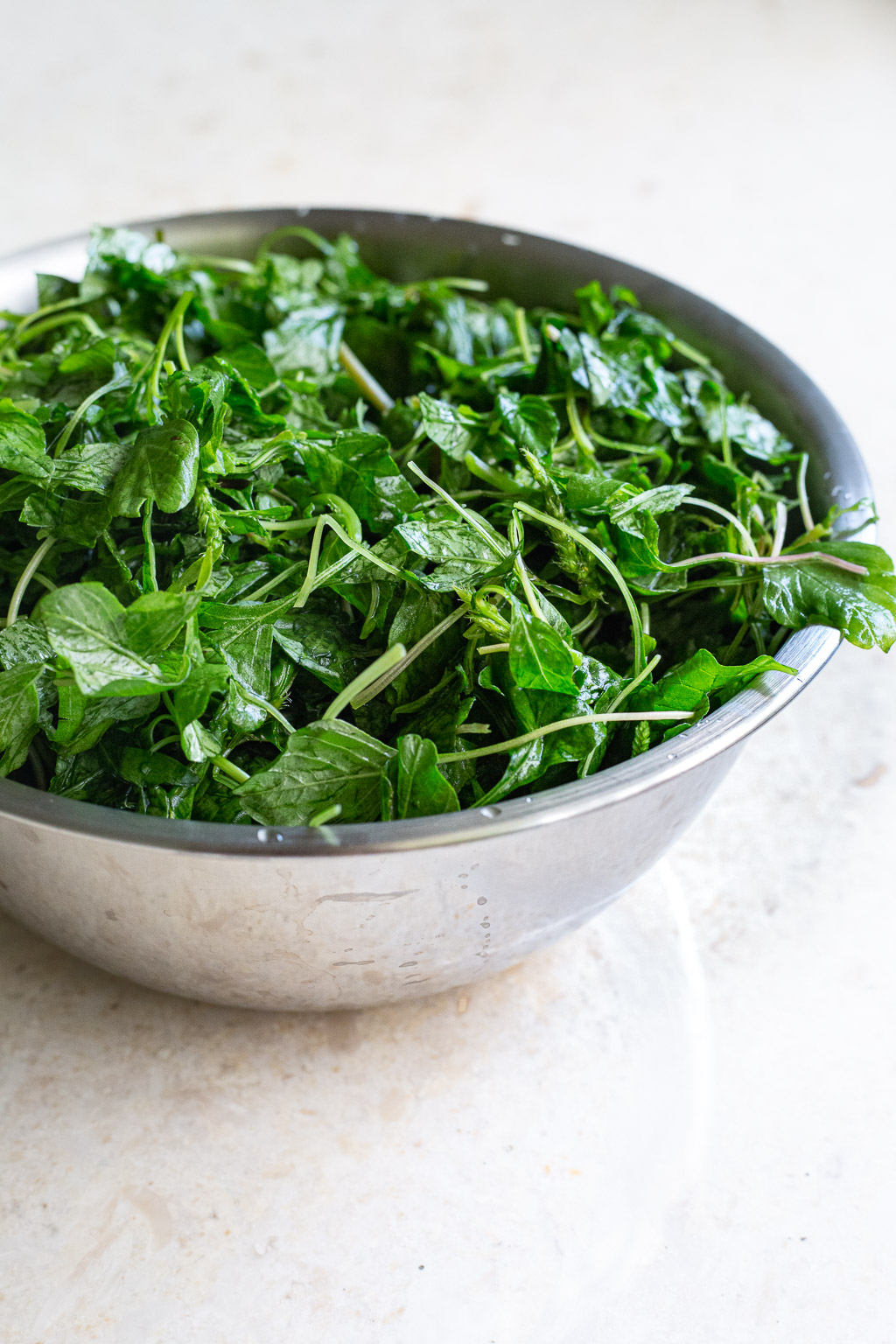

This recipe for khichdi is by no means unconventional, but I took the liberty to change things up a bit using what I found at the local market and what I had on hand. The most obvious one being the addition of greens (and local greens at that). I basically use whatever is fresh here – siru keerai, arai keerai—which are different varieties of amaranth—spinach, fenugreek greens, red amaranth, anything goes. All of these greens are ubiquitous around these parts and work well in this recipe. There’s only one rule: find what’s freshest and use that. (If you’re a hoarder like me and have a few frozen spinach pucks lurking about, feel free to use those.)
 I buy fresh turmeric when they’re in season (now), so I’ve used some in this recipe. Chopped up coarsely and in place of turmeric powder, they don’t break down and disintegrate into the dish like I thought they would the first time I tried it. Which turned out to be a good thing – they retain their shape and almost feel like an extra vegetable in here. Good texture. Sub in turmeric powder if you don’t have fresh (it’s in the recipe below).
I buy fresh turmeric when they’re in season (now), so I’ve used some in this recipe. Chopped up coarsely and in place of turmeric powder, they don’t break down and disintegrate into the dish like I thought they would the first time I tried it. Which turned out to be a good thing – they retain their shape and almost feel like an extra vegetable in here. Good texture. Sub in turmeric powder if you don’t have fresh (it’s in the recipe below).
Rice: Use any medium-grain rice. Basmati is not the best option but it would still work if that’s all you have on hand.
Dhals (lentils): again, very versatile. I mainly use a mix of dhals to get a varied nutrition profile (and also to use up the ones that are languishing at the back of my cabinet). I’ve tried a few different combinations and ratios and found that this blend gives the best result in terms of texture and flavour. But to be honest, this is one of those dishes that you throw together when you have nothing else in the house or need a quick, fuss-free meal. I wouldn’t be too hung up on it; use whatever dhal you have. It doesn’t matter too much if you change the ratios or leave one out entirely. Just make sure to stick to the overall amount used—½ cup rice : ½ cup dhal.
This khichdi is like a cheat’s risotto without any of that ‘one ladle of liquid at a time’ fussiness. To achieve this creamy consistency, once it’s finished cooking and while the khichdi is still very hot, you stir vigorously using a ladle or wooden spatula to get it creamy and homogenous. I stir for about 30 seconds or so and even add a touch of water if it appears too dry. Go by eye here. You want it to stay together but also spread out onto the plate when wiggled back and forth – that happy medium.

KHICHDI WITH GREENS
Ingredients
- ½ cup rice (any medium-grain rice)
- ¼ cup split green gram
- ⅛ cup yellow mung dhal (petite yellow lentils)
- ⅛ cup toor dal (split pigeon peas)
- 150 - 200 grams local greens or spinach (see notes)
- 1 onion, finely chopped
- 3 cloves of garlic, minced
- 1 inch piece of ginger, minced
- 3 green chillies, slit lengthwise
- 1 tsp chilli powder
- 1 tsp cumin seeds
- 2 ” piece of fresh turmeric (or ½ tsp turmeric powder)
- 1 tbsp ghee or oil (plus more to serve)
- ⅛ tsp asafoetida
- Salt, to taste
Instructions
- Wash the rice and dhals together until the water runs clear. Soak for 30 mins.
- Sort through the greens and remove any hard, woody stems at the bottom. Retain the thinner, more delicate stems that are closer to the leaves. Rinse and chop them fairly finely. Set aside.
- If using fresh turmeric, peel and discard the skin. Chop finely and set aside.
- Heat ghee (or oil) in a pressure cooker or a heavy-bottomed pot. Add cumin seeds, chopped onion and green chillies. Sauté until the onions soften and lightly brown around the edges, about 5 mins.
- Add the minced ginger, garlic, asafoetida, turmeric, chilli powder and salt. Stir for 30 seconds, keeping an eye on it so the pastes don’t burn.
- Drain the rice and dhals and add to the pressure cooker. Tip in the greens, tamping them down with a spatula until they start to wilt, about 1 minute. It might seem like a lot of greens at this stage, but they’ll wilt down significantly. Pour in 3 cups of water and stir through.
- Clamp on the pressure cooker lid and cook over a medium heat for 10-15 minutes. (If using a regular pot, cook covered until the rice is completely cooked. Check once or twice in between to make sure the bottom doesn’t burn. Add more water if it starts to dry out too much.)
- Let the pressure release naturally before opening. After opening, while the khichdi is still very hot, stir vigorously using a ladle or wooden spatula. We’re trying to get the rice and dhals to get creamy, like a risotto. I stir for about 30 seconds or so, and even add a touch of water if it appears too dry. Go by eye here.
- Serve immediately with a dollop of ghee on top.



Leave a Reply